| KIT: | Revell AG 1/72 Douglas DC-3 |
| KIT #: | 04248-0389 |
| PRICE: |
£13.99 |
| DECALS: | Two options: KLM or SwissAir |
| REVIEWER: | Carmel J. Attard |
| NOTES: | Italeri reboxing |
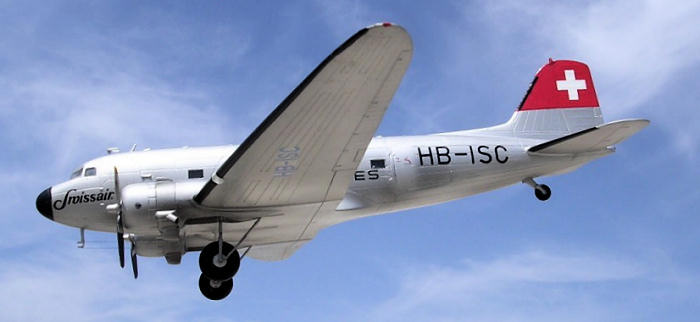
| HISTORY |
| KIT: | Revell AG 1/72 Douglas DC-3 |
| KIT #: | 04248-0389 |
| PRICE: |
£13.99 |
| DECALS: | Two options: KLM or SwissAir |
| REVIEWER: | Carmel J. Attard |
| NOTES: | Italeri reboxing |

| HISTORY |
For a good number of years the DC3was on the inventory of nearly three hundred airlines, large and small in every part of the globe, performing every kind of task imaginable. For many good number of years since the end of the war, the DC3’s commercial service outnumbered the total of all other types of transport aircraft put together. At one time it was revealed in a survey that more than twelve hundred DC-3s were in airline service.
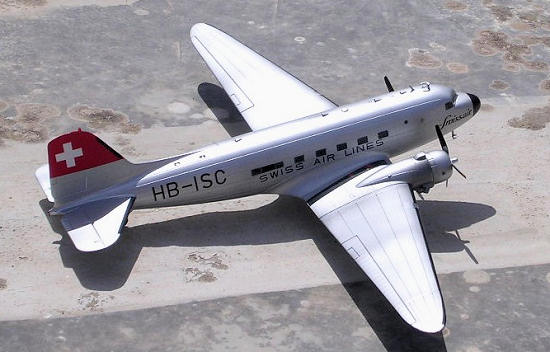
| THE KIT |
Without any doubt, the DC3 embodies a piece of aviation
history and once more Revell has come forward to release yet another kit to
represent in particular a DC3 that barely two years after the first flight it
also went into service with Swiss Air. The Revell kit
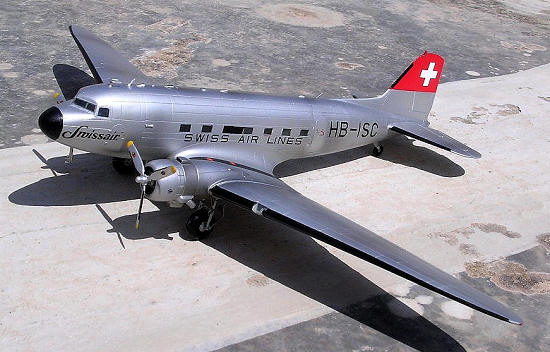 is the
same one released by Italeri some time ago. It comes in white plastic, which is
always preferable, when it comes to paint bright colours on. Basically the kit
comes in two sprues that contain all the parts needed. The kit has all the parts
common with previous Revell release C-47 Skytrain 04399-0389, the main
difference is that it is now in civil markings for which there is a choice of
two: Swiss Air or KLM. In both schemes the air intakes above the cowlings are
similar but there is a choice of bullet type radar that is carried under the
fuselage in case of the KLM version only. Other minor variations are that the
Swiss DC3 carries a complete tail cone for which a separate part is provided
whereas on the KLM this part is not needed. The Swiss machine also carries a fin
tip light that is absent on the KLM one. Incidentally this clear piece needs to
be thinned down to a more pointed shape. There is a choice of rear doors
assembly and in the case of the Swiss DC3 a blank part item"20A" is to be fitted
which contains only a small passenger entrance door. This needs to be faired
over at the periphery of the larger cargo door in order to blend with the rest
of the fuselage. There is an extra rectangular window added to the Swiss one and
this is positioned to the rear of the port row of fuselage windows. This is
premarked and the blank plastic is easily removed with a sharp modeling knife.
is the
same one released by Italeri some time ago. It comes in white plastic, which is
always preferable, when it comes to paint bright colours on. Basically the kit
comes in two sprues that contain all the parts needed. The kit has all the parts
common with previous Revell release C-47 Skytrain 04399-0389, the main
difference is that it is now in civil markings for which there is a choice of
two: Swiss Air or KLM. In both schemes the air intakes above the cowlings are
similar but there is a choice of bullet type radar that is carried under the
fuselage in case of the KLM version only. Other minor variations are that the
Swiss DC3 carries a complete tail cone for which a separate part is provided
whereas on the KLM this part is not needed. The Swiss machine also carries a fin
tip light that is absent on the KLM one. Incidentally this clear piece needs to
be thinned down to a more pointed shape. There is a choice of rear doors
assembly and in the case of the Swiss DC3 a blank part item"20A" is to be fitted
which contains only a small passenger entrance door. This needs to be faired
over at the periphery of the larger cargo door in order to blend with the rest
of the fuselage. There is an extra rectangular window added to the Swiss one and
this is positioned to the rear of the port row of fuselage windows. This is
premarked and the blank plastic is easily removed with a sharp modeling knife.
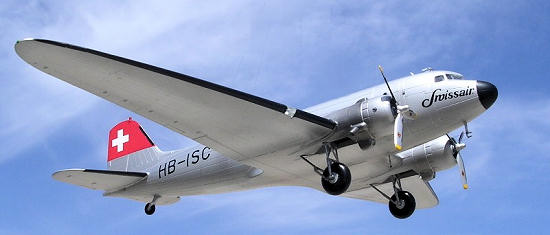
| CONSTRUCTION |
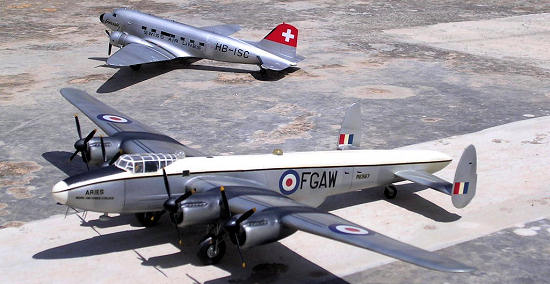 A
careful study of the instructions would reveal an additional 2.5mm diameter
porthole, at forward of fuselage, the centre of which is at a distance of 12mm
ahead of the rectangular windows on the starboard side and is at a level 2mm
higher than the upper edges of the windows. There are also two rectangular
windows, 2x3.5mm at the rear starboard fuselage side.
A
careful study of the instructions would reveal an additional 2.5mm diameter
porthole, at forward of fuselage, the centre of which is at a distance of 12mm
ahead of the rectangular windows on the starboard side and is at a level 2mm
higher than the upper edges of the windows. There are also two rectangular
windows, 2x3.5mm at the rear starboard fuselage side.
| COLORS & MARKINGS |
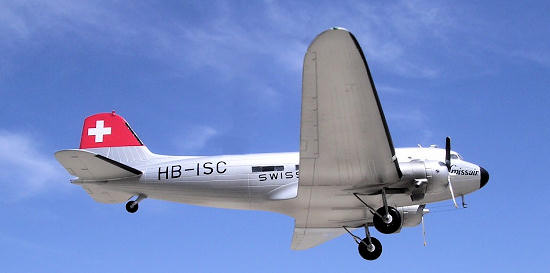 There is
variation to the propeller paintwork depending which of the two liveries is
representing but common propeller decal markings also come with the sheet. Both
aircraft are overall metal finish and this simplified the paintwork as there was
minimum of areas that needed masking. I preferred to leave the upper tail unit
in white finish so that the bright red decal comes out more in contrast whereas
if one makes the KLM version then only the rudder is left in white i.e. where
the brightly coloured decal is fixed. Weathering areas in line with exhaust
outlets and other areas prone to erosion during service was applied with a fine
discoloured shade of paint using a mix of semi matt varnish and a darker colour
as desired depending on the area applied.
There is
variation to the propeller paintwork depending which of the two liveries is
representing but common propeller decal markings also come with the sheet. Both
aircraft are overall metal finish and this simplified the paintwork as there was
minimum of areas that needed masking. I preferred to leave the upper tail unit
in white finish so that the bright red decal comes out more in contrast whereas
if one makes the KLM version then only the rudder is left in white i.e. where
the brightly coloured decal is fixed. Weathering areas in line with exhaust
outlets and other areas prone to erosion during service was applied with a fine
discoloured shade of paint using a mix of semi matt varnish and a darker colour
as desired depending on the area applied.
This was yet another Dakota built and first of its type in civil markings. I am surprised at the variation of Swiss Air marking liveries that exist. Previous to this release the Italeri Company released a DC3 Kit No 132, which came with some six airline markings, two of which were one for the Swiss Airline colours and the other Classic Air that also carried red tail unit with a white cross.
| CONCLUSIONS |
June 2008
If you would like your product reviewed fairly and quickly, please contact me or see other details in the Note to Contributors.